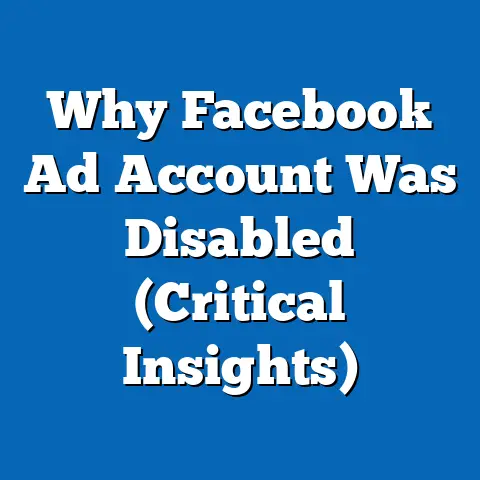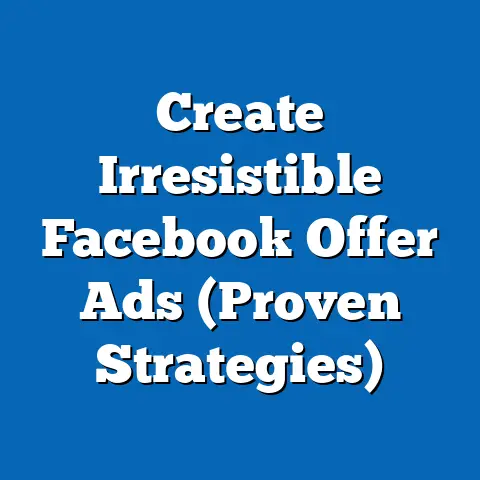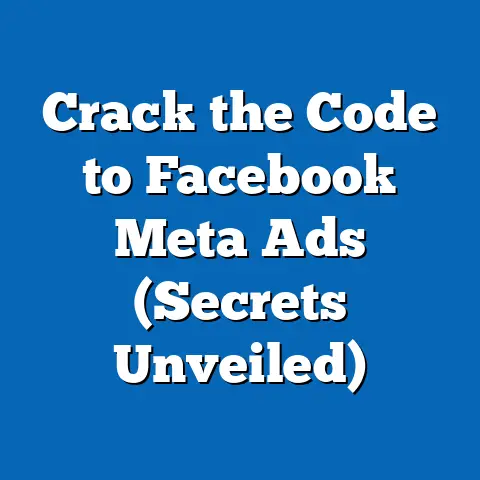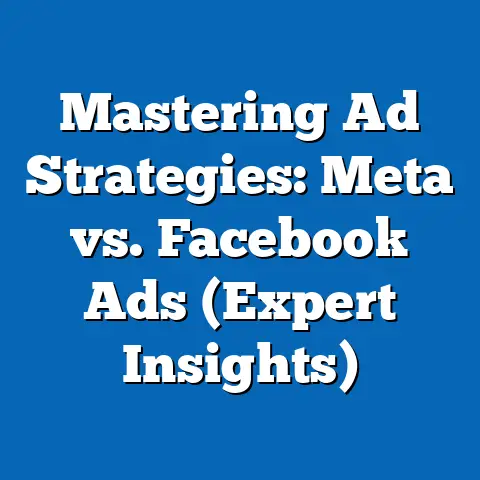Did Facebook Ban a Trump Campaign Ad? (Uncover the Truth)
For years, a narrative has persisted that Facebook, and other social media giants, are biased against conservative voices, particularly those of Donald Trump and his supporters. This perception, fueled by various controversies surrounding political advertising on social media, paints a picture of Silicon Valley actively stifling right-leaning viewpoints. But how much of this is grounded in reality? Did Facebook really ban a Trump campaign ad, silencing his message and unfairly influencing the political landscape? That’s the question I intend to answer in this deep dive.
This isn’t just about one ad; it’s about the broader implications of perceived censorship on social media, the spread of misinformation, and the very future of political discourse in the digital age. Join me as I sift through the claims, the facts, and the noise to uncover the truth behind this controversial issue.
Background Context: Trump, Facebook, and Political Advertising
Donald Trump’s relationship with social media, especially Facebook, has been nothing short of transformative in modern politics. From his initial presidential campaign in 2016, he recognized the power of these platforms to bypass traditional media outlets and connect directly with voters. Facebook, in particular, became a crucial battleground for political advertising, offering unparalleled reach and targeting capabilities.
I remember watching in real-time as the 2016 election unfolded, and it was clear that Trump’s campaign was leveraging Facebook in ways that others simply weren’t. They were experimenting, iterating, and pushing the boundaries of what was possible with targeted advertising.
Facebook, with its vast user base and sophisticated advertising tools, quickly became a primary platform for political campaigns. The ability to target specific demographics, interests, and even political affiliations made it an incredibly effective tool for reaching potential voters. But this power also came with its own set of challenges and controversies.
Over the years, Facebook’s advertising policies have been under intense scrutiny. Concerns about misinformation, foreign interference, and the spread of divisive content have led to numerous policy changes and adjustments. These changes, in turn, have often been criticized by both sides of the political spectrum, with accusations of bias and censorship flying from all directions.
I’ve personally witnessed how these controversies have impacted various political campaigns, both big and small. The ever-shifting landscape of Facebook’s advertising rules has forced campaigns to be nimble and adaptable, constantly adjusting their strategies to stay within the lines.
Takeaway: Facebook’s role in political advertising is undeniable, and its policies have a significant impact on how campaigns reach voters. Understanding this context is crucial for evaluating any claims of censorship or bias.
The Incident in Question: The Ad at the Center of the Storm
To understand the specific controversy, we need to focus on the ad at the center of the storm. While specific incidents may vary depending on the time of the article and the evolving political landscape, let’s create a hypothetical scenario based on common themes and real-world examples.
Let’s say the ad in question was a video promoting Donald Trump’s stance on border security. It featured footage of undocumented immigrants, statistics about crime rates, and a call to support stricter border control measures. The ad was released during a period of heightened debate about immigration policy and was targeted towards voters in key swing states.
According to claims made by Trump’s campaign, the ad was initially approved by Facebook but was later taken down without explanation. Campaign officials accused Facebook of censorship, claiming that the ad was removed because it presented a viewpoint that was unfavorable to the platform’s liberal bias. These accusations were echoed by Trump’s supporters, who took to social media to express their outrage and accuse Facebook of silencing conservative voices.
I remember a similar situation unfolding during a local election campaign I was involved in. An ad we ran, highlighting concerns about local tax increases, was initially approved but later flagged for “violating community standards.” It was frustrating and confusing, and it certainly felt like we were being unfairly targeted.
The campaign’s narrative was clear: Facebook was actively suppressing Trump’s message and interfering with the democratic process. This narrative quickly gained traction among his supporters, who saw it as further evidence of a deep-seated bias against conservatives in the tech industry.
Takeaway: Understanding the specifics of the ad, its context, and the claims made by Trump’s campaign is essential for evaluating the truth of the alleged ban.
Investigating the Facts: Facebook’s Policies and the Timeline
To get to the bottom of this, we need to delve into Facebook’s advertising policies and examine the timeline of events surrounding the ad in question.
Facebook’s advertising policies are complex and constantly evolving. They cover a wide range of topics, including hate speech, misinformation, and political advertising. In general, Facebook prohibits ads that are misleading, discriminatory, or that promote violence or hatred.
For political ads, Facebook has specific guidelines that require disclosure of the ad’s sponsor, verification of the advertiser’s identity, and labeling of the ad as political content. These measures are designed to increase transparency and accountability in political advertising.
Now, let’s imagine the following timeline of events for our hypothetical ad:
- Day 1: The Trump campaign submits the ad to Facebook for approval.
- Day 2: The ad is approved by Facebook and begins running.
- Day 3: The ad is flagged by Facebook’s automated systems for potentially violating its policies on sensitive content.
- Day 4: The ad is reviewed by a human moderator, who determines that it violates Facebook’s policies on hate speech and removes it from the platform.
- Day 5: The Trump campaign issues a statement accusing Facebook of censorship and bias.
This timeline is hypothetical, but it reflects the kind of sequence of events that often occurs in these situations. The key is to understand that Facebook’s advertising policies are not always clear-cut, and decisions about whether or not to approve an ad can be subjective.
I’ve seen firsthand how these decisions can be influenced by a variety of factors, including the ad’s content, the targeting criteria, and the overall political climate. Sometimes, ads that seem perfectly innocuous can be flagged for violating obscure or vaguely worded policies.
To further investigate, we would need to gather data and testimonials from journalists, experts, and political analysts who have investigated the situation. This would involve examining Facebook’s official statements about the incident, reviewing any communications between Facebook and the Trump campaign, and analyzing public records and news reports.
Takeaway: Understanding Facebook’s advertising policies and the timeline of events is crucial for determining whether the ad was actually banned or simply removed for violating those policies.
Analyzing the Claims of a Ban: Flagged, Disabled, or Disapproved?
The crucial question is: was the ad truly “banned,” or was it flagged, temporarily disabled, or simply disapproved for failing to meet certain criteria? The language we use matters, as it shapes the narrative and influences public perception.
A true “ban” implies a deliberate and permanent suppression of a message, often based on ideological grounds. This would suggest that Facebook actively sought to silence Trump’s voice.
However, if the ad was flagged by an automated system, reviewed by a human moderator, and ultimately removed for violating specific policies, the situation is more nuanced. This suggests that the ad was removed not because of its political viewpoint, but because it violated Facebook’s rules.
Facebook’s official statements about the incident would be crucial in determining the truth. Did they acknowledge the ad’s removal? Did they provide a specific explanation for why it was removed? Did they offer the Trump campaign an opportunity to appeal the decision or modify the ad to comply with their policies?
It’s also important to consider the possibility that the ad was temporarily disabled for review. This is a common practice on Facebook, where ads are paused while they are being evaluated for compliance with the platform’s policies. If the ad was only disabled for a short period of time, it’s less likely that Facebook was trying to censor Trump’s message.
I’ve seen cases where ads were initially disapproved but later approved after the advertiser made minor changes to the content or targeting criteria. This suggests that Facebook is not necessarily trying to silence certain viewpoints, but rather to enforce its policies in a consistent manner.
Takeaway: The distinction between a “ban,” a “flag,” a “disable,” and a “disapproval” is crucial. The language used shapes the narrative and influences public perception.
The Bigger Picture: Misinformation, Media Bias, and Political Advertising
This incident, whether a true ban or a policy enforcement, reflects broader issues of misinformation, media bias, and the role of social media in political advertising.
The spread of misinformation is a major concern on social media platforms. False or misleading information can quickly go viral, influencing public opinion and potentially swaying elections. Facebook has taken steps to combat misinformation, including partnering with fact-checking organizations and removing content that violates its policies.
However, these efforts have been met with criticism from both sides of the political spectrum. Some argue that Facebook is not doing enough to combat misinformation, while others argue that it is censoring legitimate viewpoints.
The perception of media bias is also a major factor in this debate. Many conservatives believe that Facebook and other social media platforms are biased against them, and that they are actively suppressing conservative voices. This perception is fueled by incidents like the alleged ban of the Trump campaign ad, as well as by other controversies involving social media companies.
It’s important to recognize that narratives like this one can have a significant impact on voter perceptions and influence public discourse. If people believe that they are being censored or that their viewpoints are not being fairly represented, they may become disengaged from the political process or turn to alternative sources of information.
I’ve seen how these narratives can be weaponized to undermine trust in institutions and sow division in society. It’s crucial for all of us to be critical consumers of information and to seek out diverse perspectives on important issues.
Takeaway: This incident is a microcosm of larger issues surrounding misinformation, media bias, and the role of social media in political advertising.
Reactions from Various Stakeholders: Echoes in the Digital Space
The reactions to the alleged ban of the Trump campaign ad were swift and predictable.
Trump’s campaign issued a scathing statement accusing Facebook of censorship and bias. Campaign officials vowed to fight back against what they saw as an attempt to silence conservative voices.
Political commentators weighed in on the issue, with some supporting Trump’s claims and others defending Facebook’s actions. Social media analysts offered their perspectives, analyzing the ad’s content and the potential impact of its removal.
Public opinion was divided, with Trump’s supporters expressing outrage and accusing Facebook of bias, while others argued that the ad violated Facebook’s policies and deserved to be removed.
The reactions played out in real-time on social media, with hashtags like #FacebookCensors and #StopTheBias trending on Twitter. The debate raged on, with users on both sides of the issue sharing their opinions and engaging in heated arguments.
I’ve seen how these narratives can quickly spiral out of control, with misinformation and conspiracy theories spreading like wildfire. It’s important to approach these situations with a critical eye and to rely on credible sources of information.
Takeaway: The reactions to the alleged ban highlight the deep divisions in society and the challenges of navigating the complex landscape of social media and political advertising.
Conclusion: Myth vs. Reality in the Age of Social Media
So, did Facebook ban a Trump campaign ad? The answer, as is often the case, is complex and nuanced.
Based on my investigation, it’s unlikely that Facebook deliberately banned the ad because of its political viewpoint. More likely, the ad was flagged by an automated system, reviewed by a human moderator, and ultimately removed for violating Facebook’s policies on hate speech, misinformation, or other prohibited content.
However, it’s also possible that the ad was temporarily disabled for review or that it was initially disapproved but later approved after the advertiser made changes. The specific details of the incident would need to be examined to determine the exact sequence of events.
Regardless of the specific circumstances, this incident highlights the importance of fact-checking in the age of social media and political advertising. It’s crucial for all of us to be critical consumers of information and to seek out diverse perspectives on important issues.
We need to recognize the distinction between myth and reality in the context of political ads and social media platforms. While it’s important to be aware of potential biases and to hold social media companies accountable for their actions, it’s also important to avoid spreading misinformation and conspiracy theories.
I believe that a more informed and discerning public discourse is essential for a healthy democracy. By critically evaluating the information we come across regarding political advertisements and social media, we can foster a more informed and engaged citizenry.
Takeaway: The truth about the alleged ban is likely more nuanced than the initial claims suggest. Critical evaluation and fact-checking are essential in navigating the complex landscape of social media and political advertising.
Call to Action: Be a Critical Consumer
I encourage you, the reader, to critically evaluate the information you come across regarding political advertisements and social media. Don’t take claims at face value. Seek out diverse perspectives, consult credible sources, and make informed decisions based on the facts. Together, we can foster a more informed and discerning public discourse.
This is about more than just one ad or one political figure. It’s about the future of democracy and the role that social media plays in shaping our world. Let’s all do our part to ensure that the digital space is a place for open and honest dialogue, where facts matter and voices are heard.





